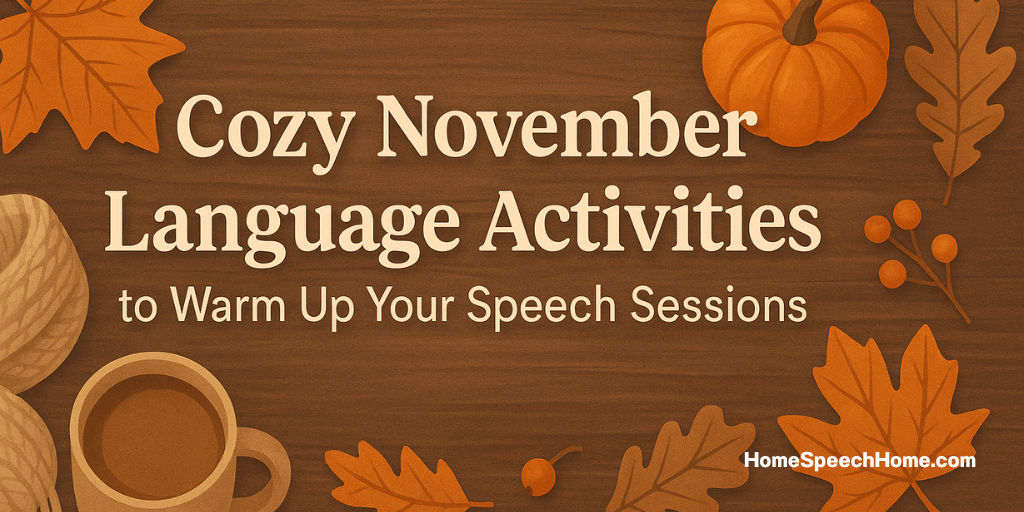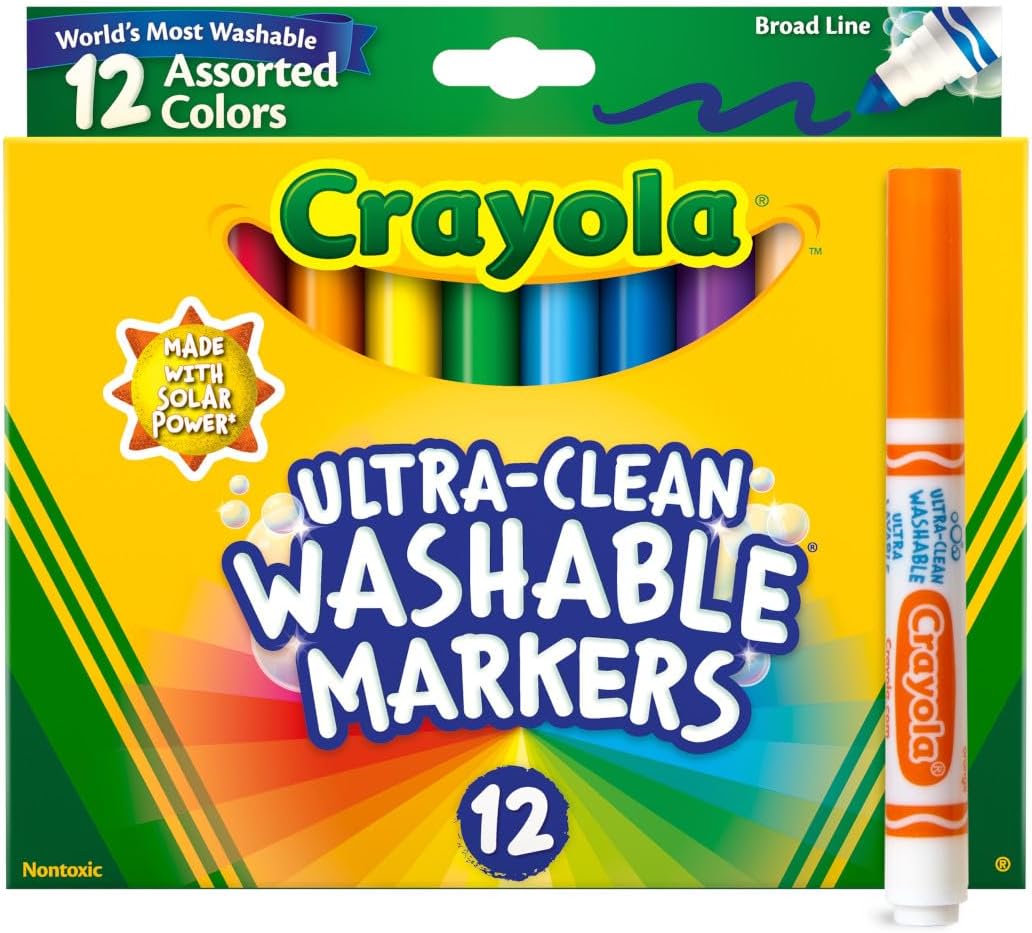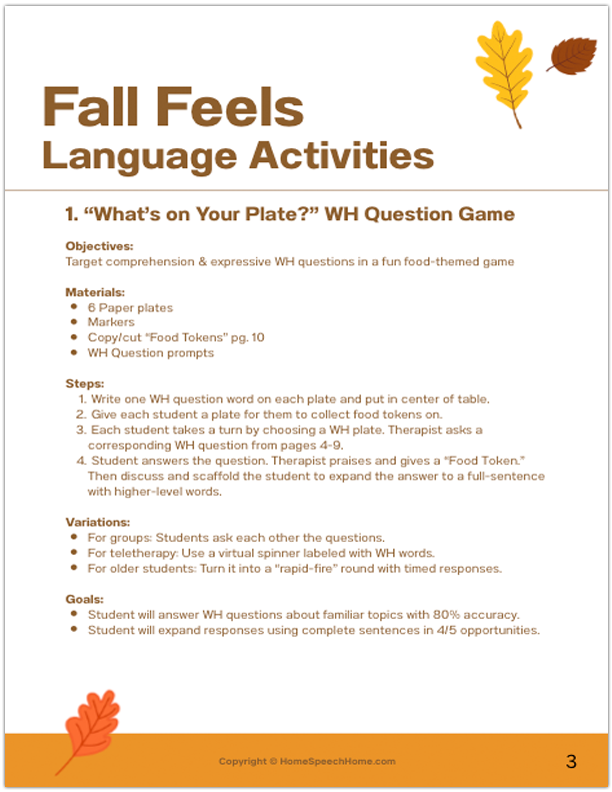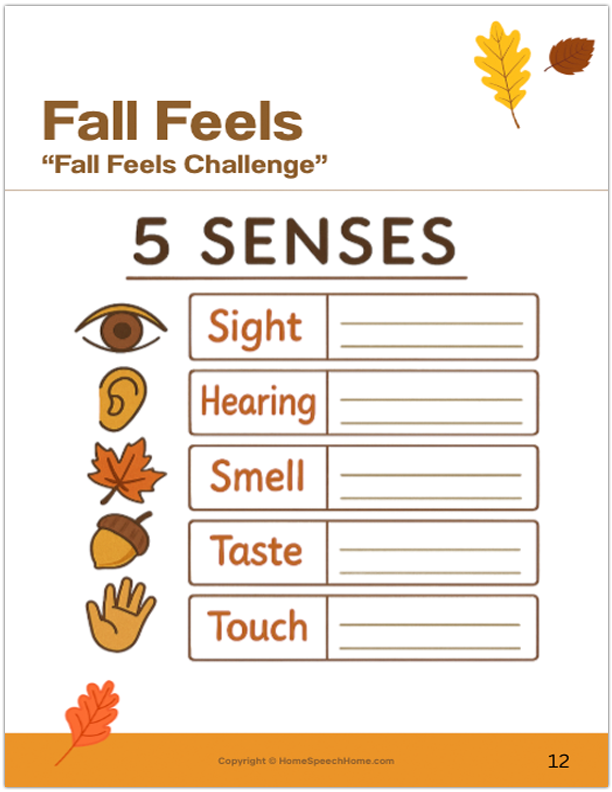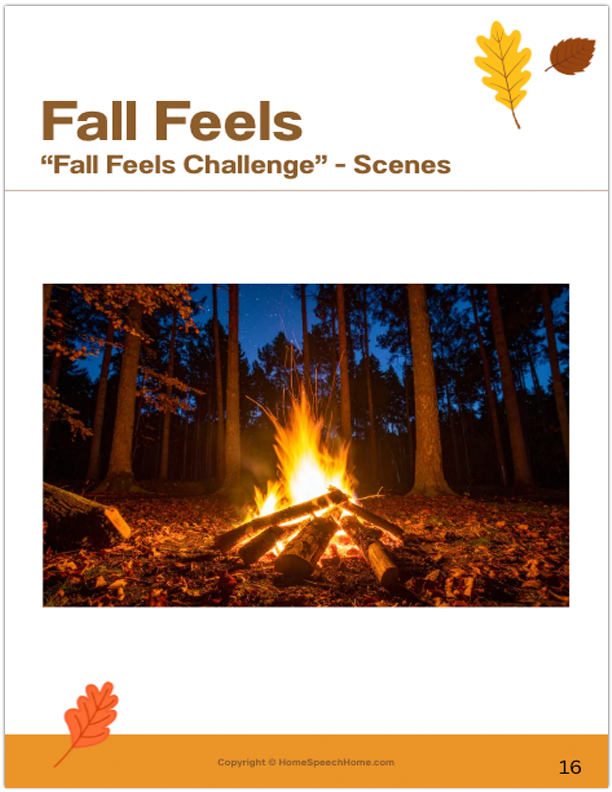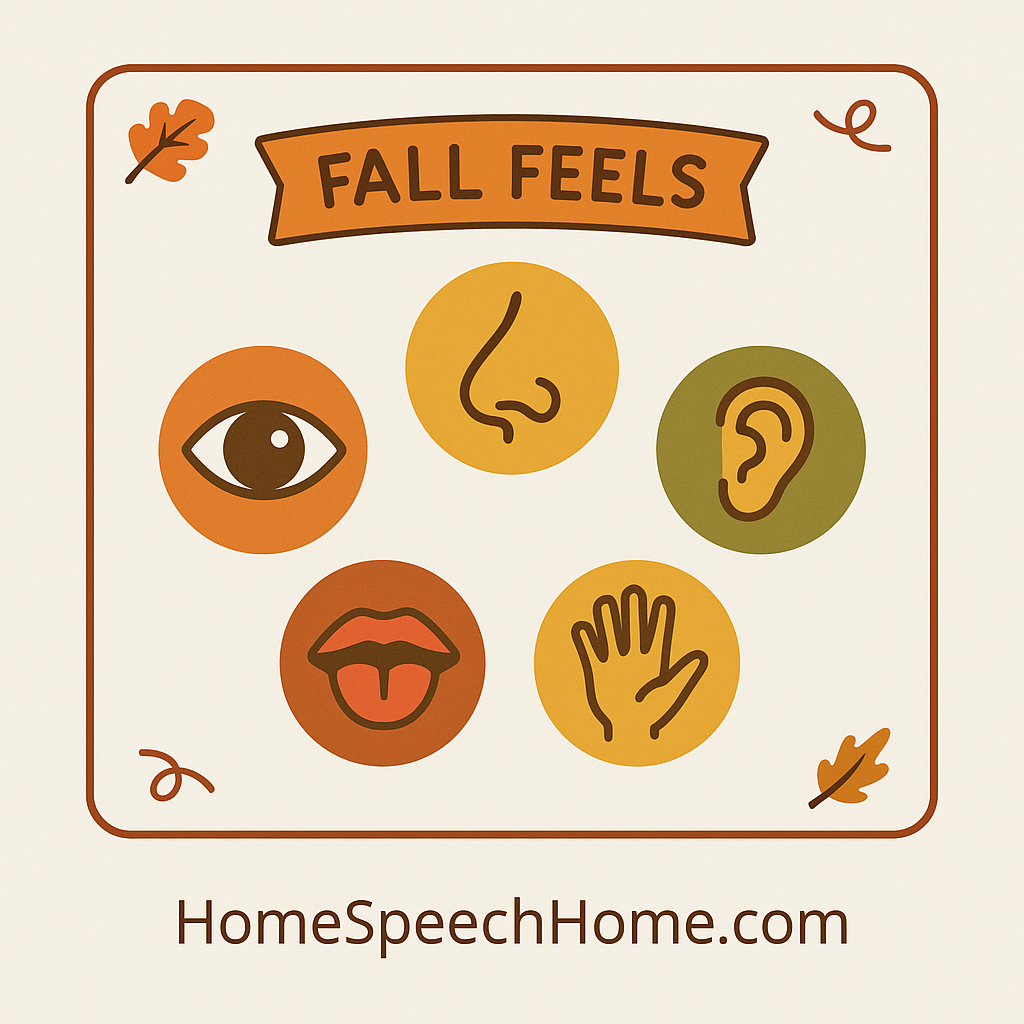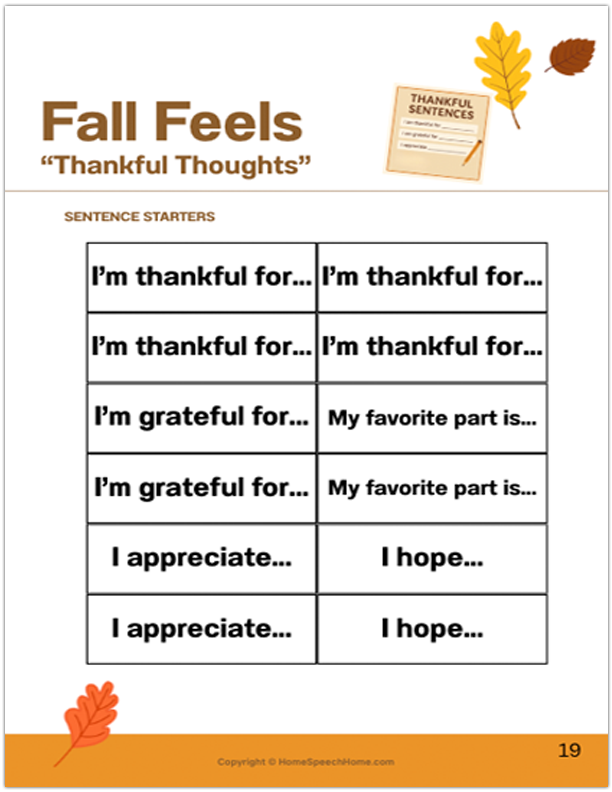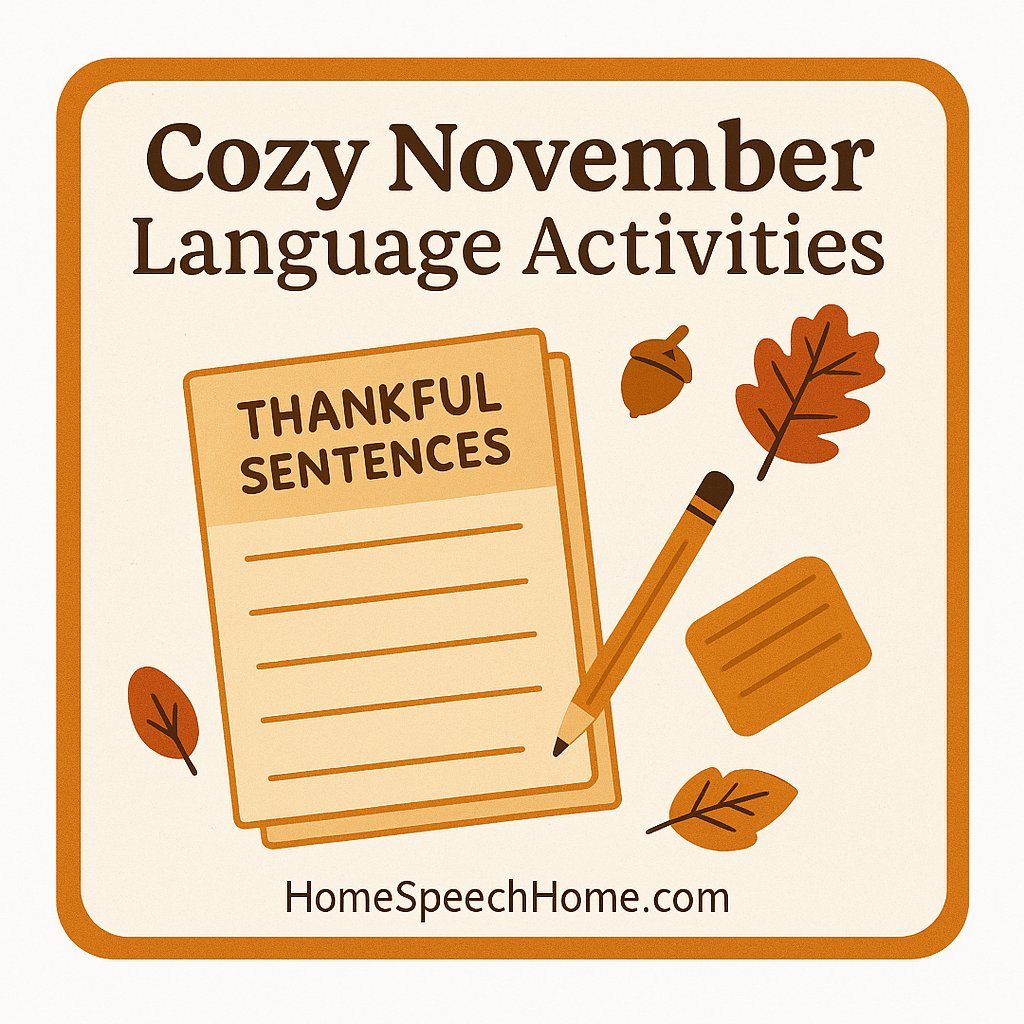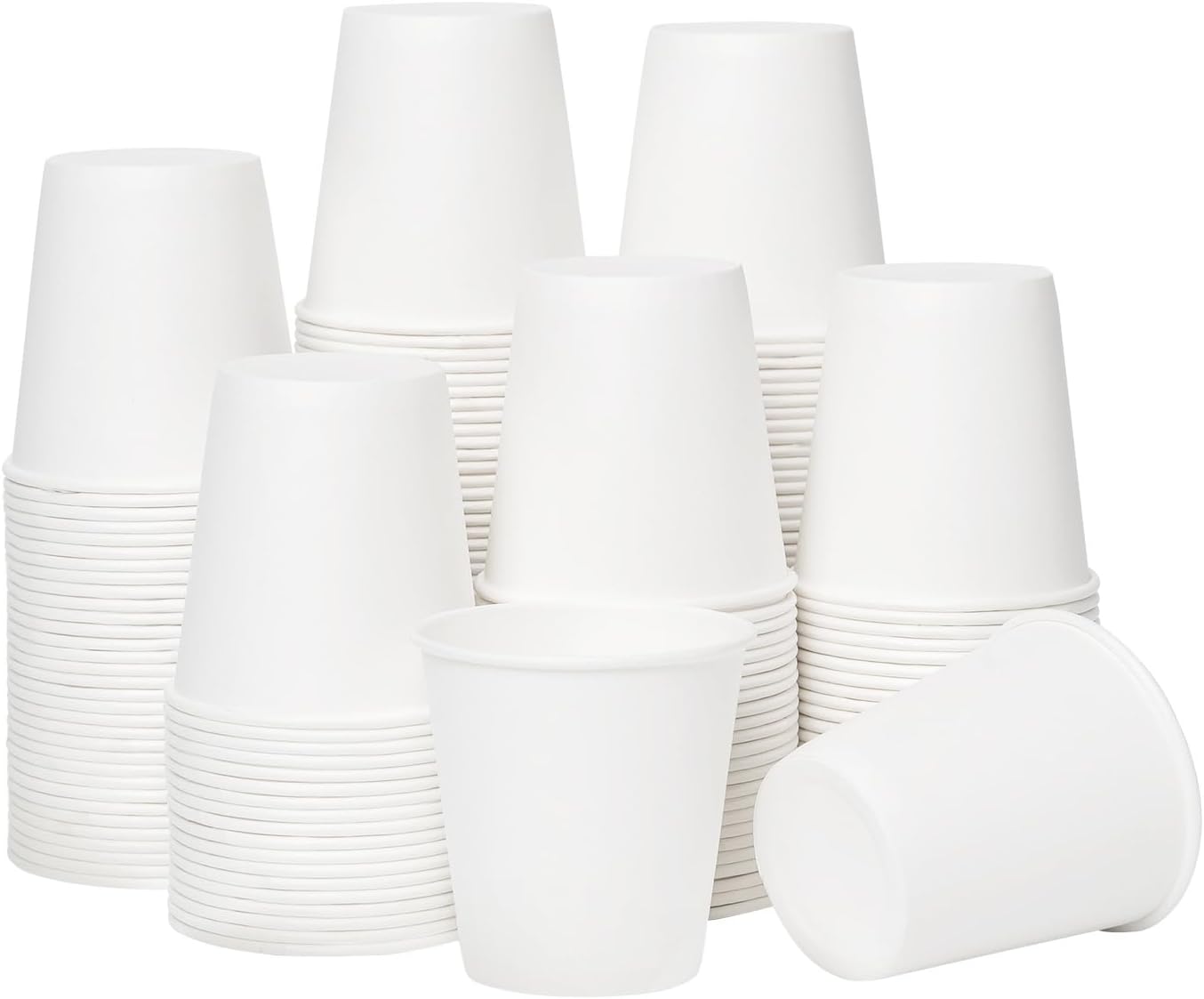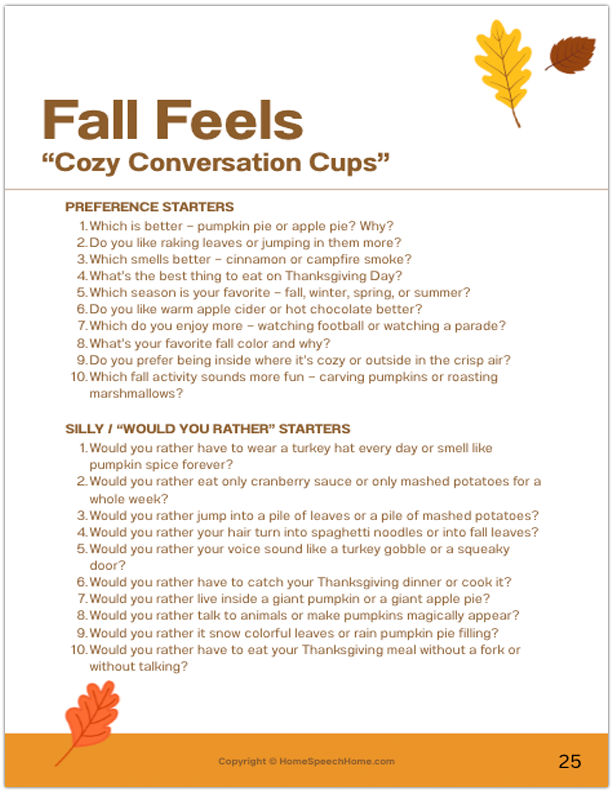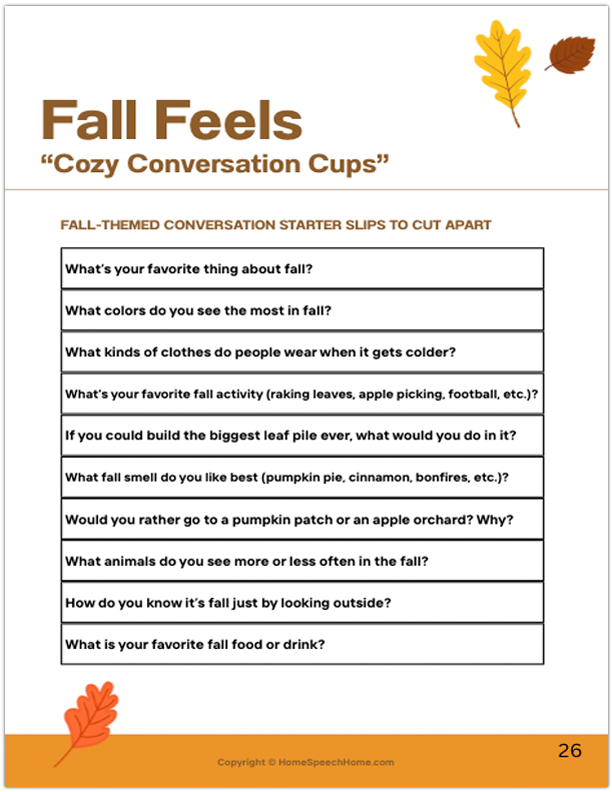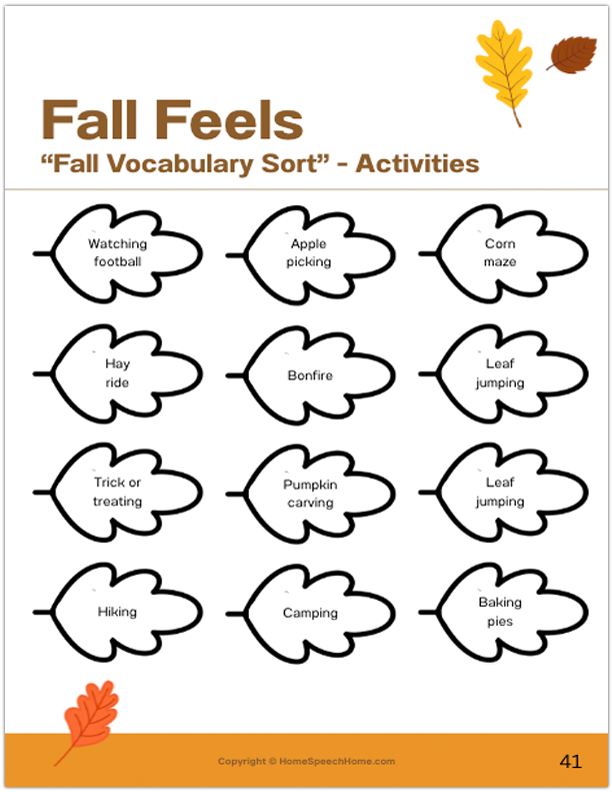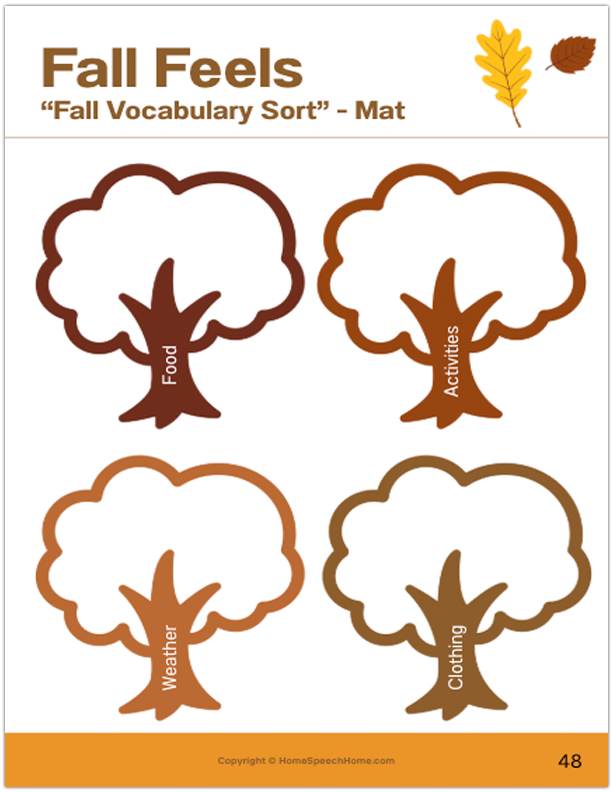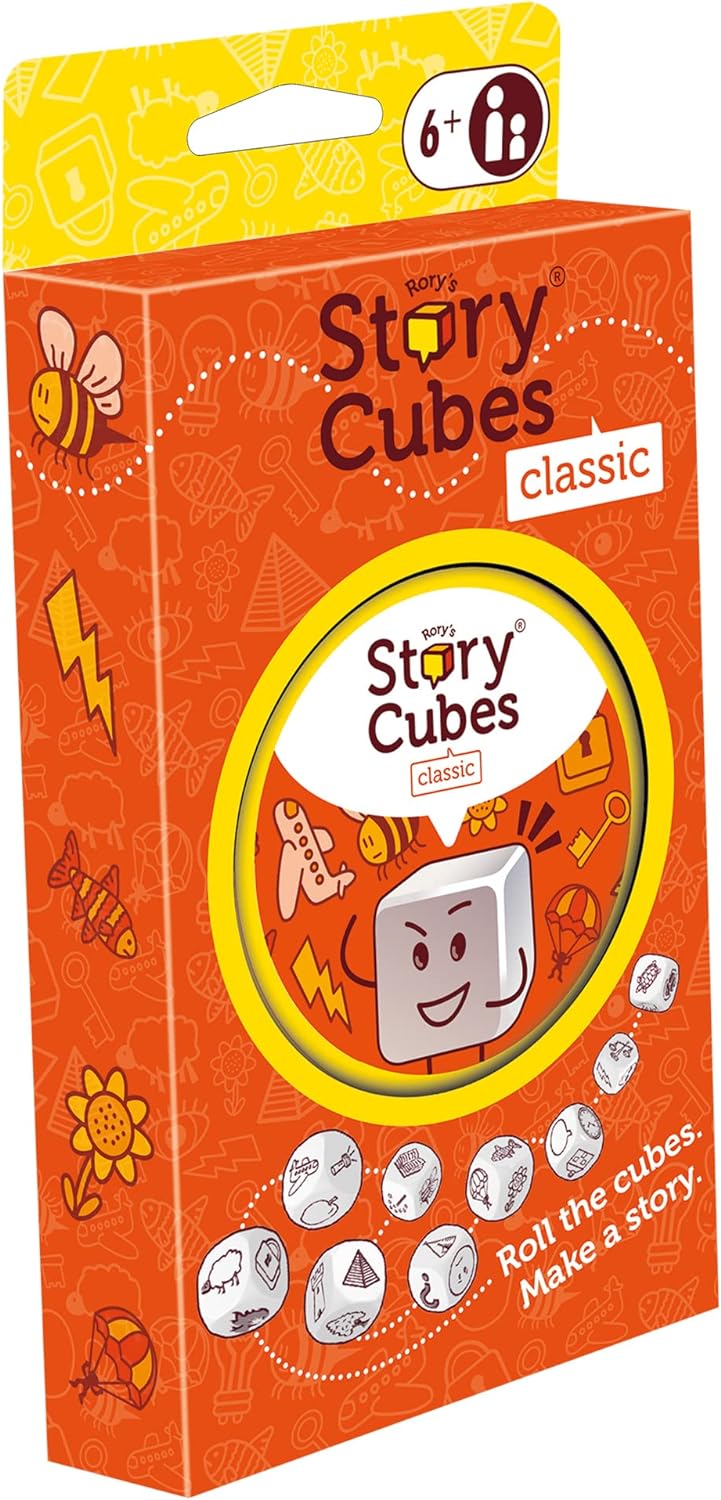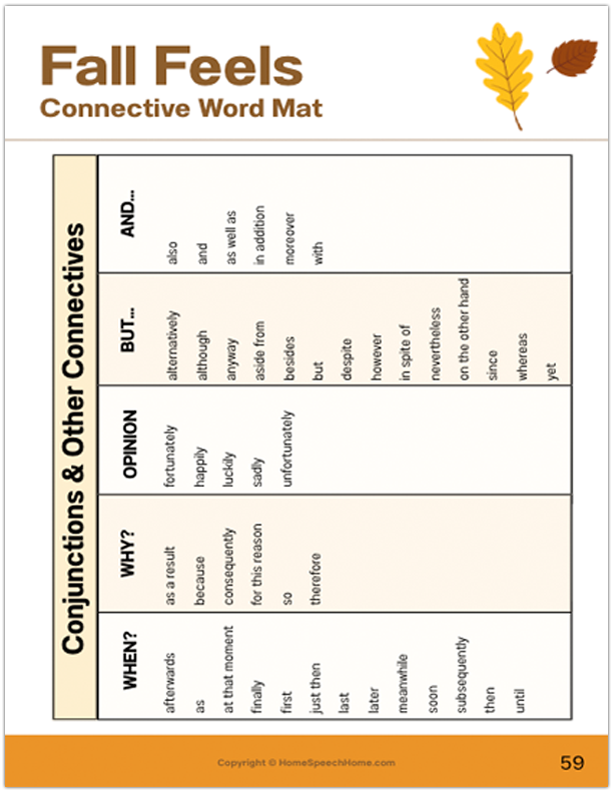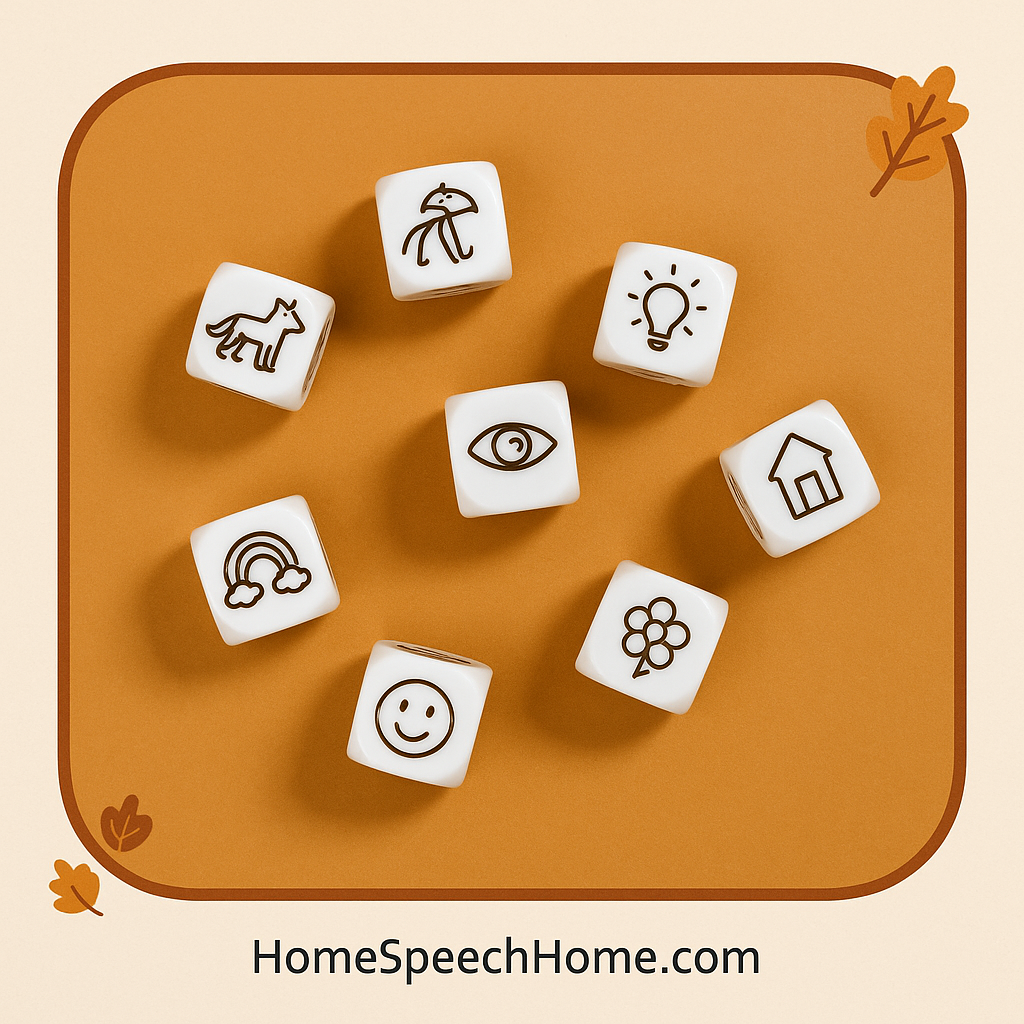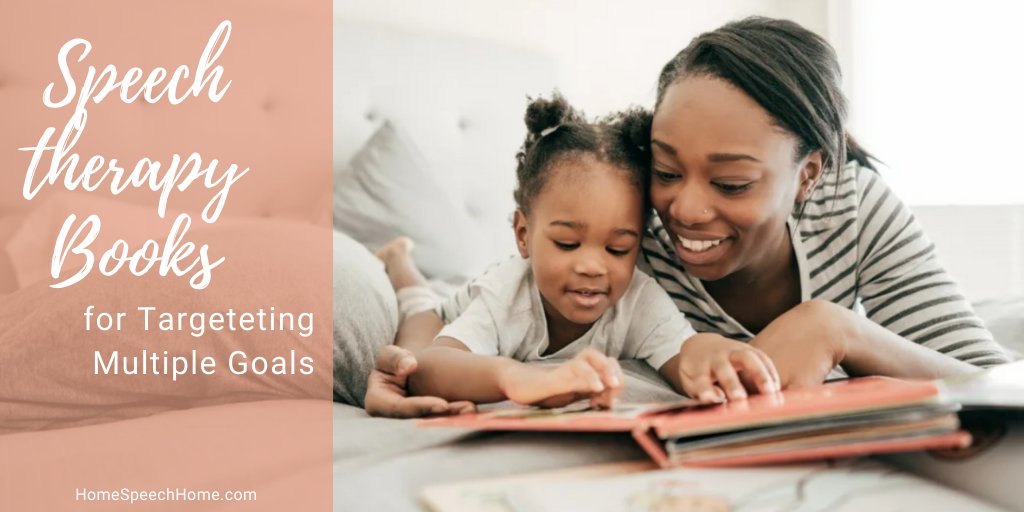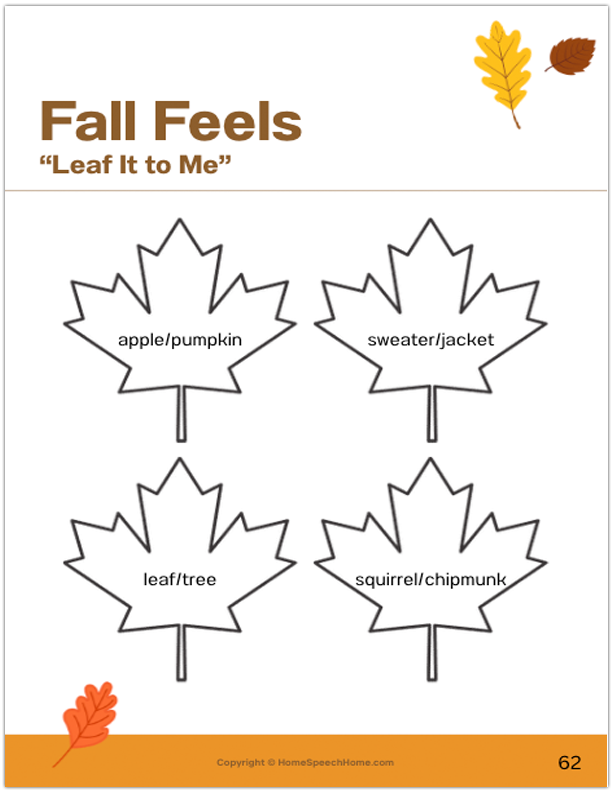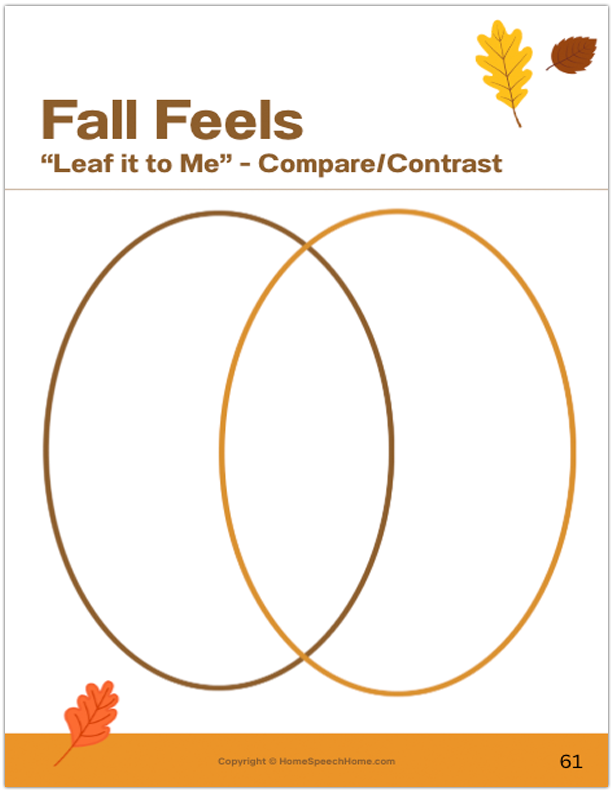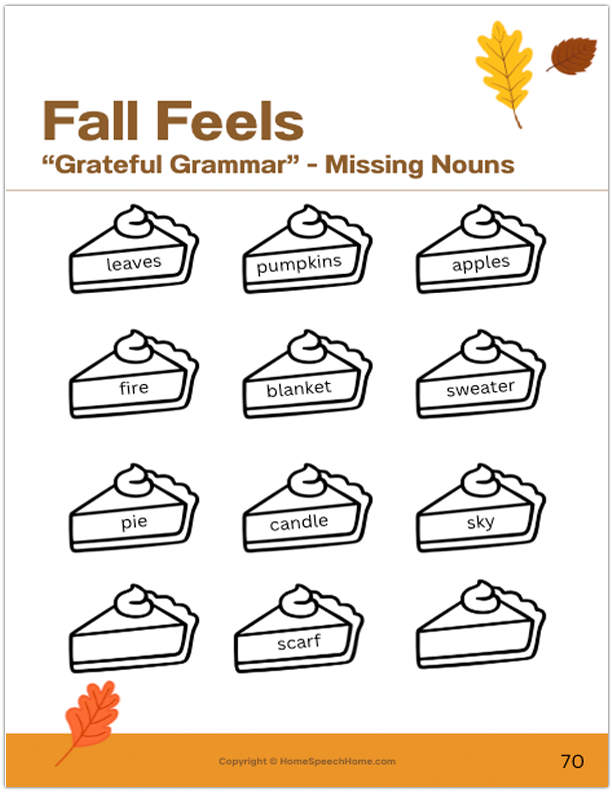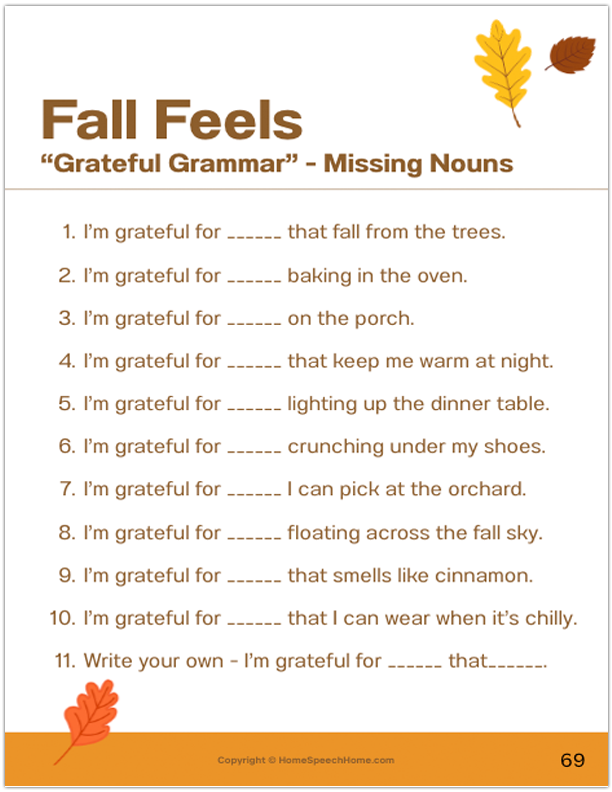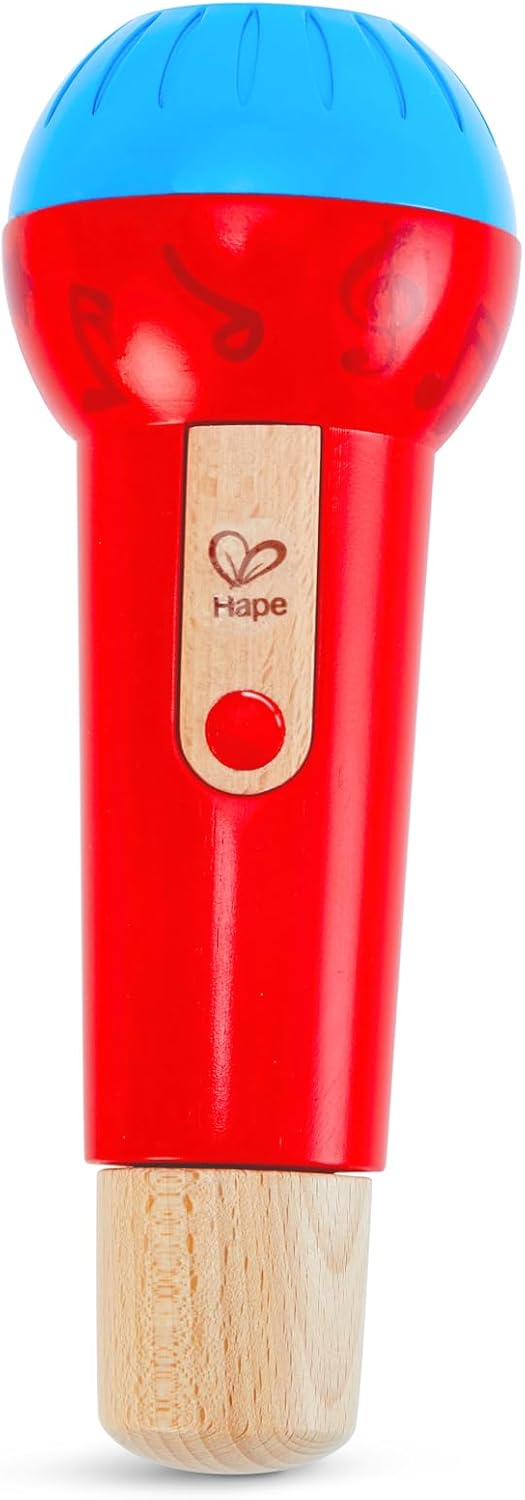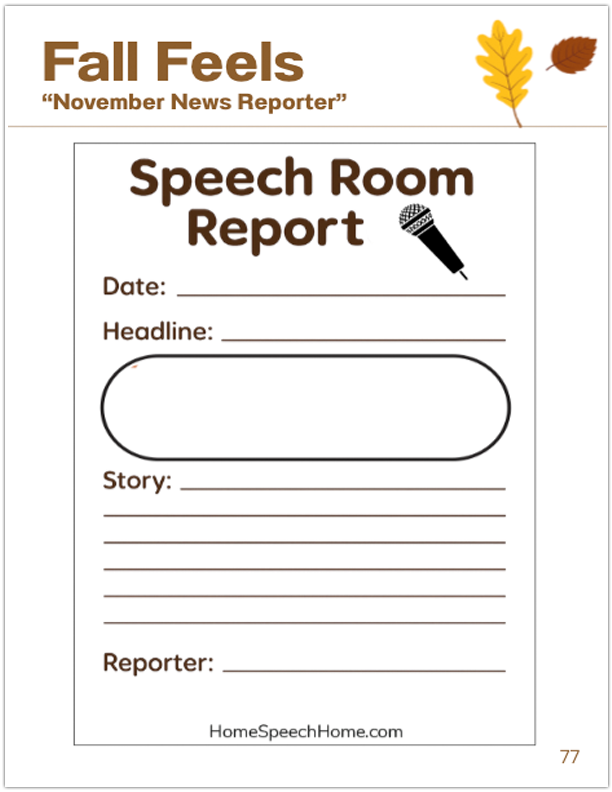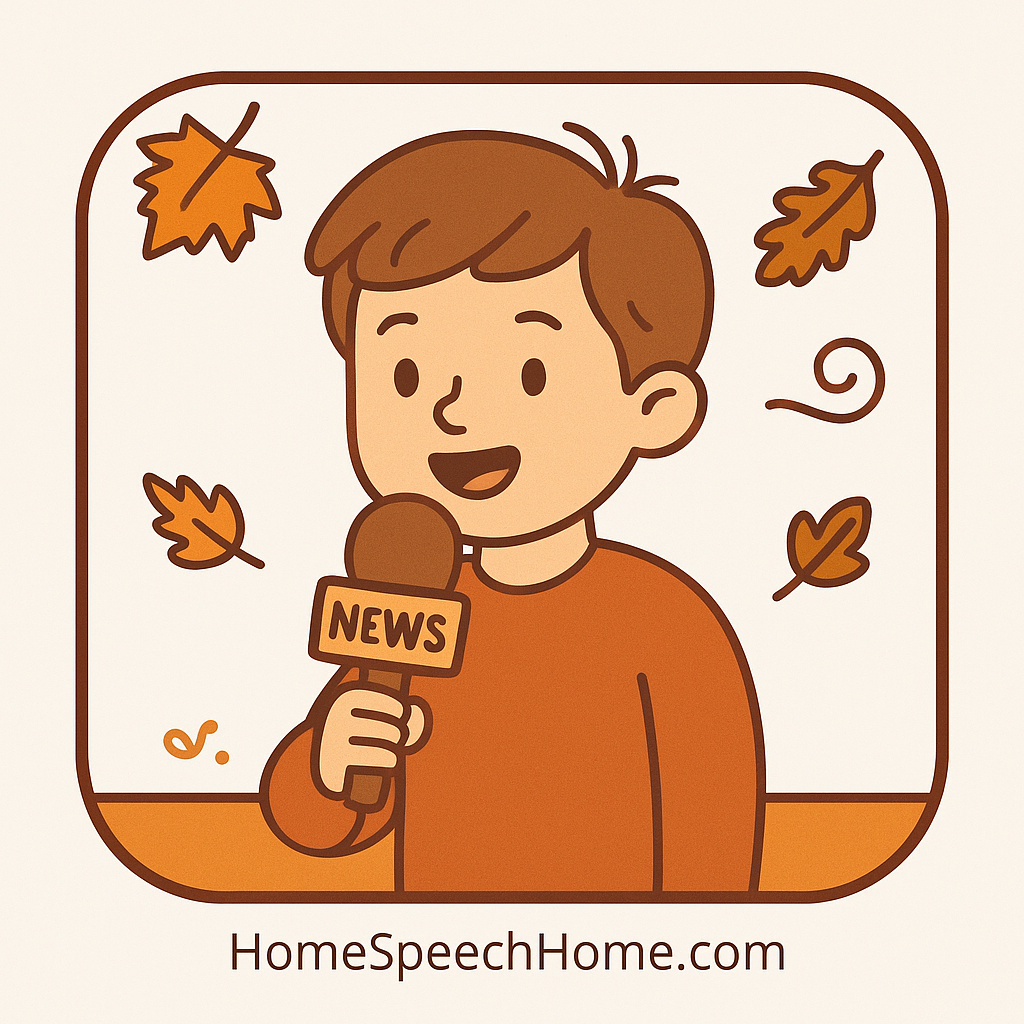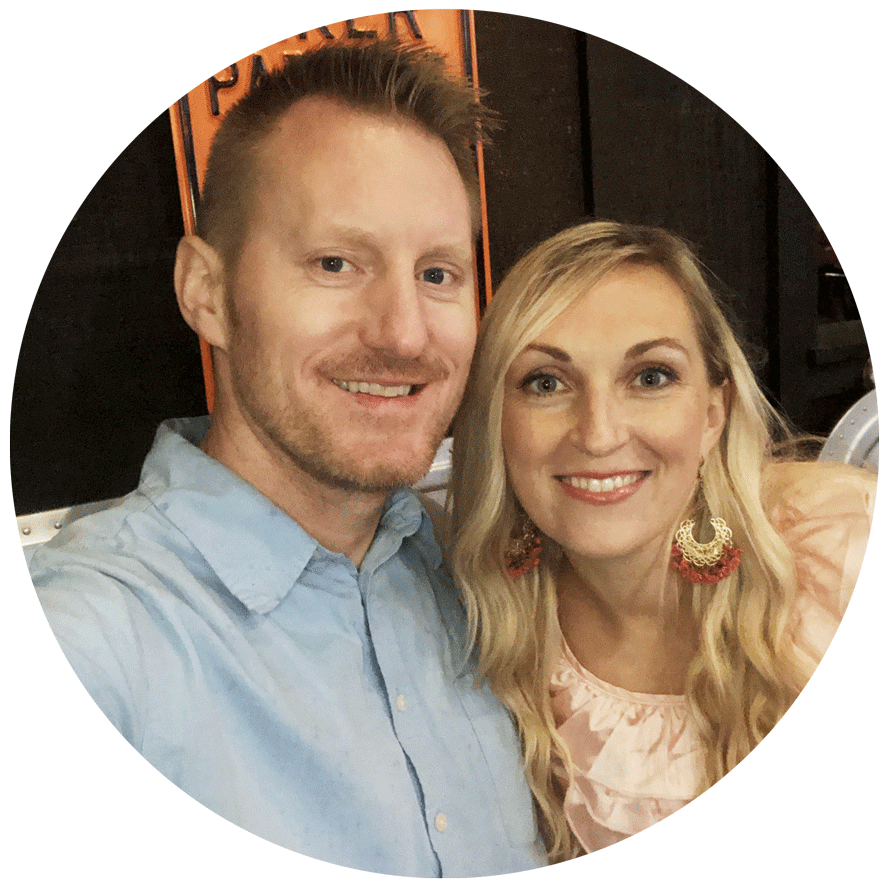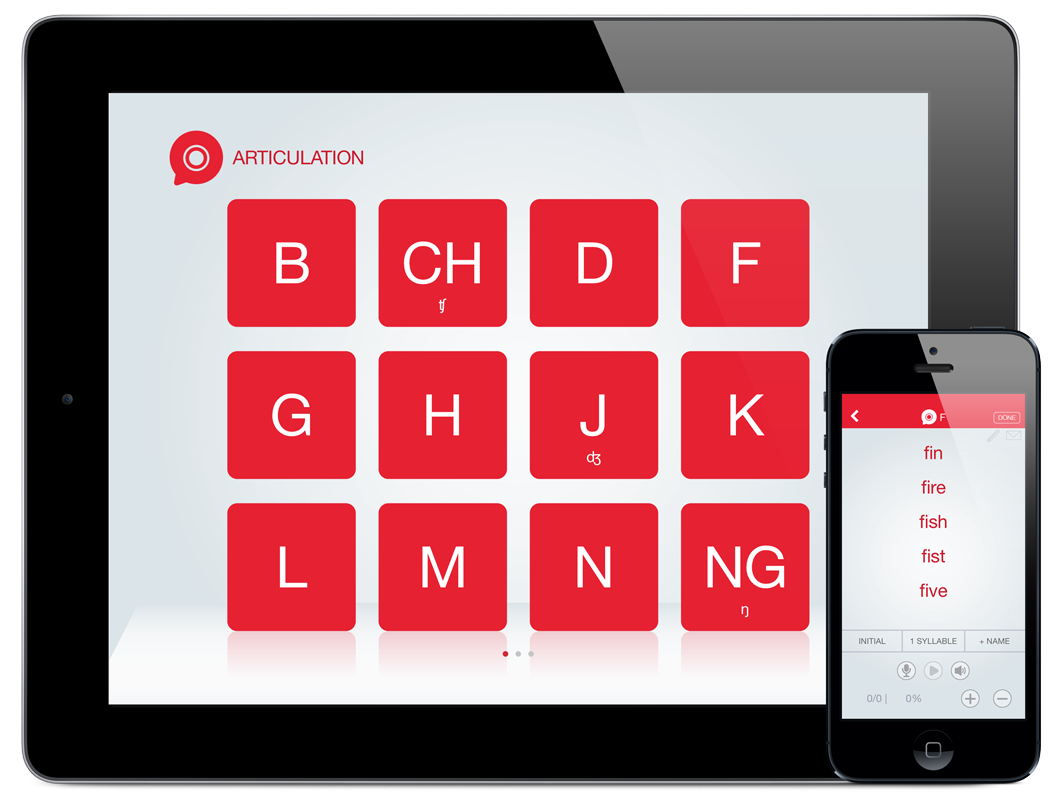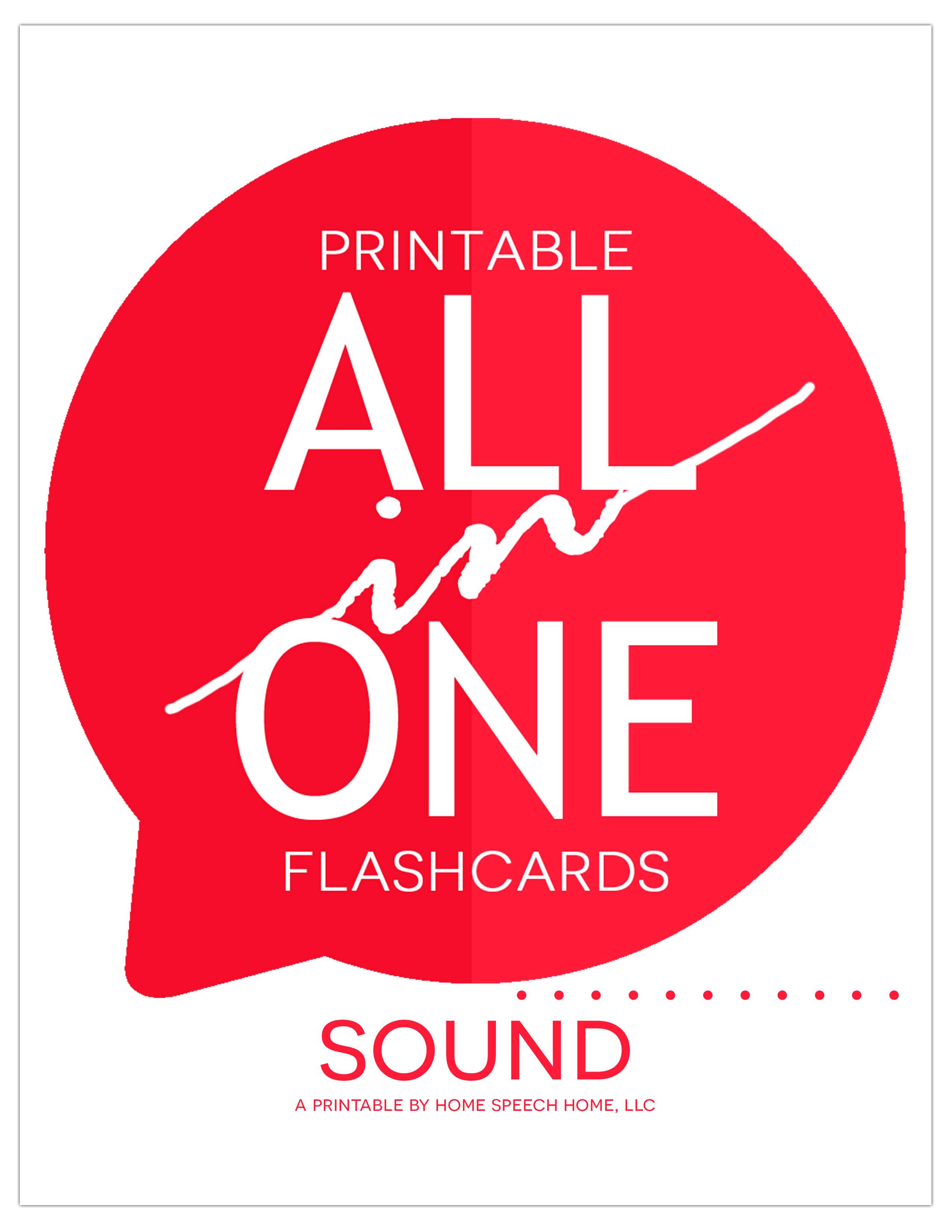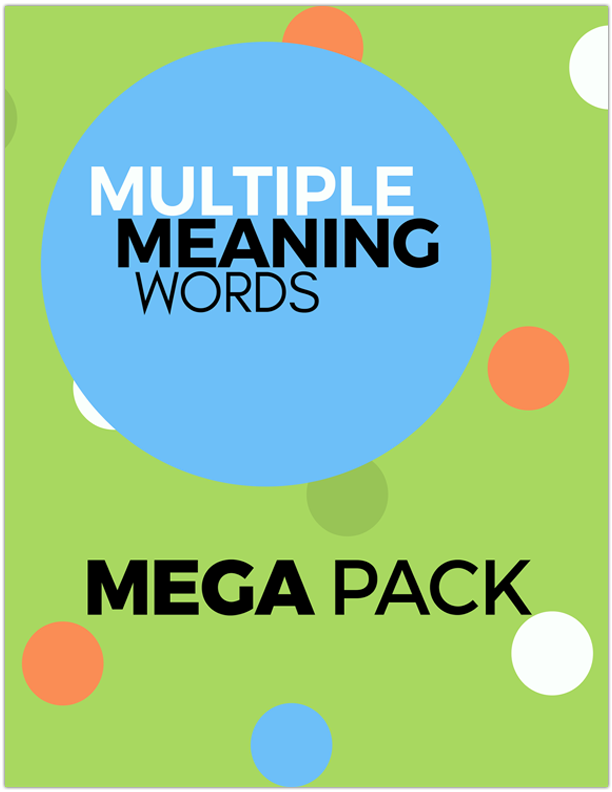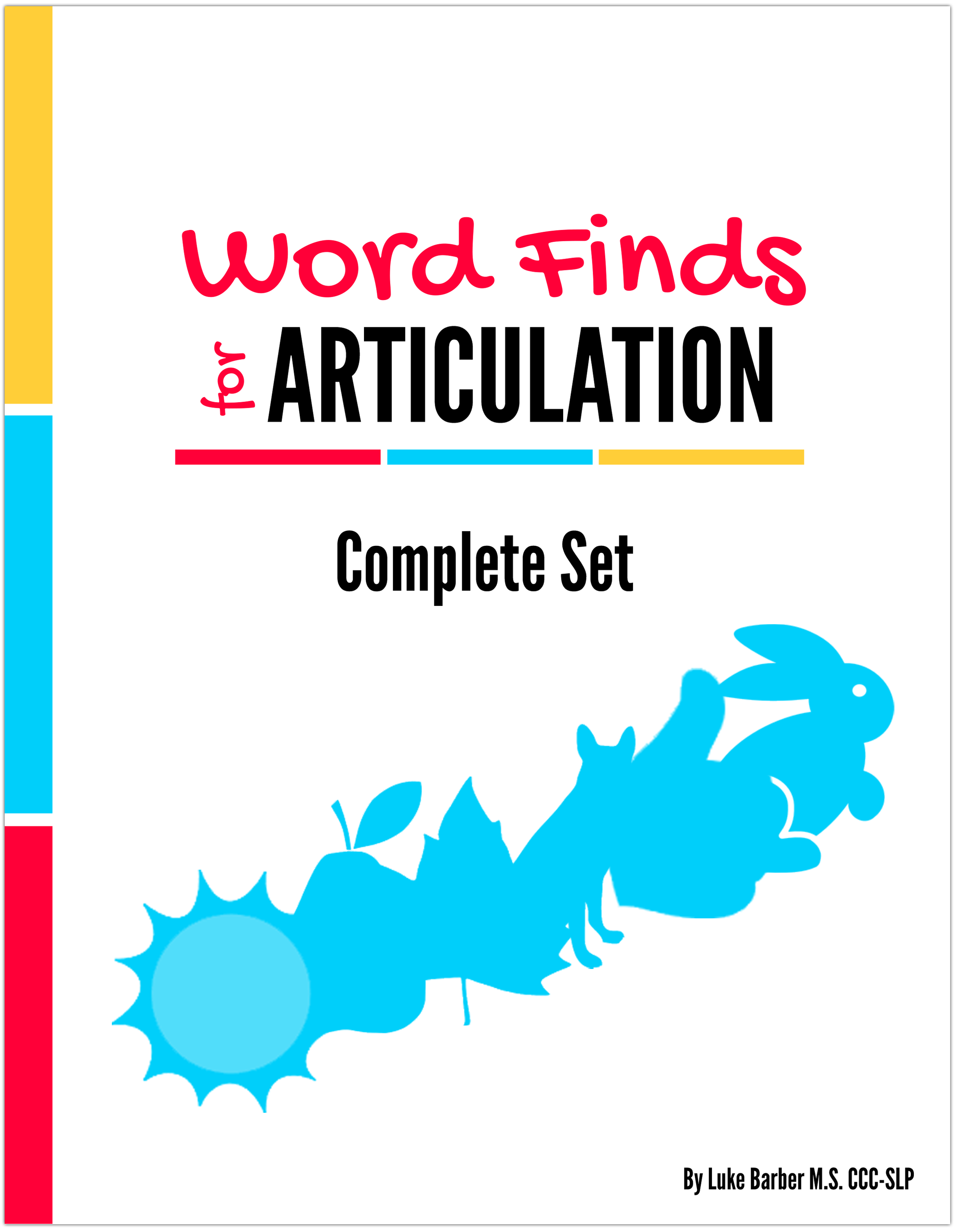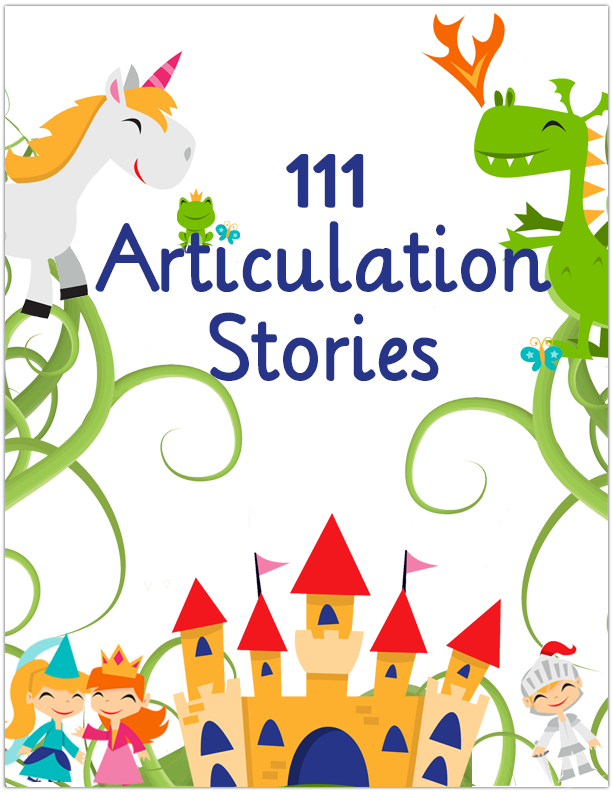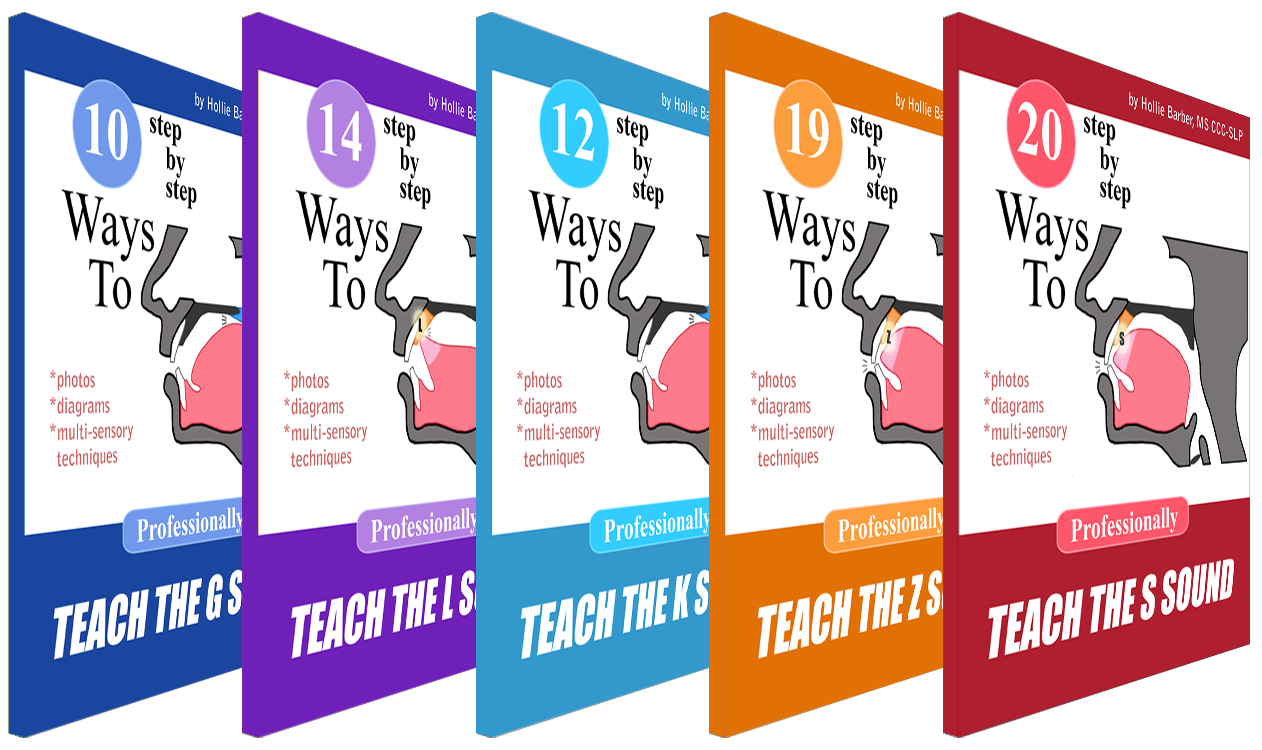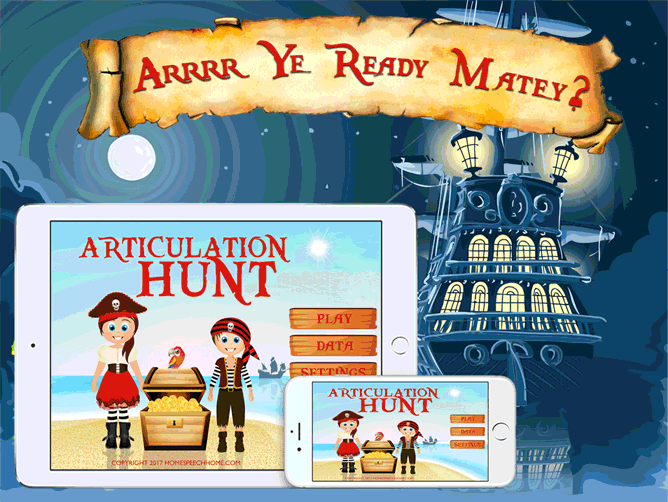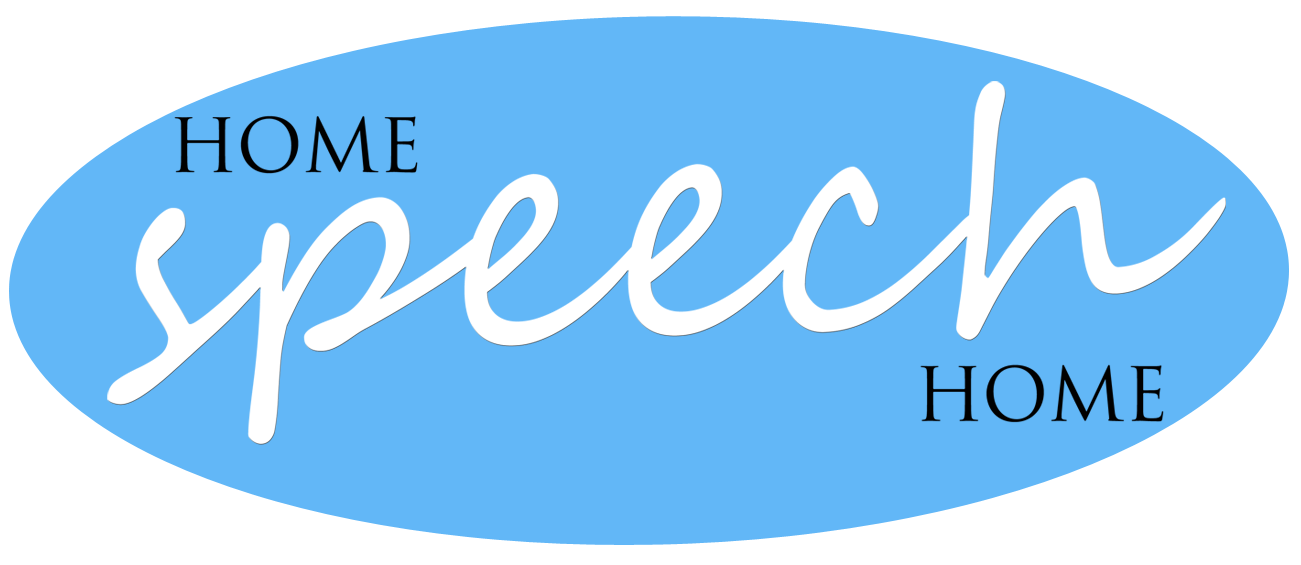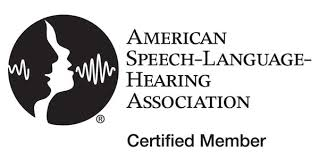Cozy November Language Therapy Activities for SLPs
November is a wonderful, calm-before-the-holidays month. It’s the perfect time to slow things down, refocus on meaningful conversations, and strengthen language foundations before the excitement of December hits.
November naturally invites reflection on: gratitude, change, family, and cozy routines.
These low-prep, high-impact language activities will help naturally teach fall and November themed WH questions, sequencing, describing, and vocabulary lessons.
NEW! Bring cozy, fall-themed fun into your therapy sessions with the "Fall Feels" Language Pack
1. “What’s on Your Plate?” WH Question Game
Objective:
Target comprehension & expressive WH questions in a fun food-themed game
Materials Needed:
- 6 Paper plates
- Markers
- Copy/cut “Food Tokens”
- "Food Tokens"
- WH Questions prompts
(Tokens & Prompts included in the "Fall Feels" Language Pack)
Steps:
- Write one WH question word on each plate and put in center of table.
- Give each student a plate for them to collect food tokens on.
- Each student takes a turn by choosing a WH plate. Therapist asks a corresponding WH question from pages 4-9.
- Student answers the question. Therapist praises and gives a “Food Token.” Then discuss and scaffold the student to expand the answer to a full-sentence with higher-level words.
Variations:
- For groups: Students ask each other the questions.
- For teletherapy: Use a virtual spinner labeled with WH words.
- For older students: Turn it into a “rapid-fire” round with timed responses.
Goals:
- Student will answer WH questions about familiar topics with 80% accuracy.
- Student will expand responses using complete sentences in 4/5 opportunities.
2. “Fall Feels” Descriptive Language Challenge
Objective:
Build vocabulary and descriptive sentence structure using sensory language.
Materials Needed:
- "5 Senses Chart" for each student
- “Fall Scenes”
(both included in the "Fall Feels" Language Pack)
Steps:
- Display a “Fall Scene.”
- Ask students to describe it using each sense (“What might it smell like?”), by speaking out or writing their answers on the chart.
- Encourage adjectives, comparisons, and feeling words.
- You can write sentences together and highlight descriptive words.
Variations:
- For teletherapy: Use virtual fall backgrounds or YouTube ambient scenes.
- For advanced students: Add figurative language (similes/metaphors).
Goals:
- Student will use 2–3 sensory descriptors in a sentence.
- Student will identify adjectives and sensory vocabulary with 80% accuracy.
3. “Thankful Thoughts” Sentence Expansion Strips
Objective:
Improve sentence length, syntax, and expressive detail.
Materials Needed:
- “Sentence Starters”
- “Expansion Strips”
(both included in the "Fall Feels" Language Pack)
Steps:
- Start with a simple sentence starter: “I’m thankful for…” and have the student add any noun they think of.
- Add an expansion strip: “because…,” “when…,” or “that helps me…”
- Example: “I’m thankful for my dog because he keeps me warm when it’s cold.”
- Model expanding and rearranging sentences for fluency.
Variations:
- For younger students: Draw or use picture cards.
- For groups: Build silly chain sentences together.
Goals:
- Student will produce expanded sentences with at least one conjunction in 4/5 trials.
- Student will use complex sentence forms with 70% accuracy.
SEE ALSO: The Best Free App for Speech Therapy
4. “Cozy Conversation Cups”
Objective:
Practice pragmatic and turn-taking language skills in natural conversation.
Materials Needed:
- Paper/plastic cup for each student
- Your favorite “Conversation Starter Slips”
(included in the "Fall Feels" Language Pack) - Optional: Hot cocoa, marshmallows, spoons, or pretend play mugs
Steps:
- Divide all strips into the “Cozy Conversation Cocoa Cups.”
- Students take turns drawing a slip and responding. Marshmallows can be earned and received with their spoon.
- Encourage follow-up questions and on-topic comments.
- SLP models conversation repair and topic maintenance.
Variations:
- Add nonverbal communication focus: eye contact, tone, gestures.
- For older students: Include abstract topics (gratitude, change, patience).
Goals:
- Student will maintain a reciprocal conversation for at least 3 turns.
- Student will ask and answer questions appropriately in 4/5 opportunities.
5. “Sequence the Seasons”
Objective:
Strengthen sequencing skills and weather/ season knowledge.
Materials Needed:
- Fall Sequencing Cards
(included in the "Fall Feels" Language Pack)
Steps:
- Present “Fall Sequencing Cards”.
- Have students order them correctly (“What comes first?”).
- Add transition words (“first, next, then, last”).
- Retell the sequence aloud or in writing.
Variations:
- Use personal routines instead and have the students draw their own 4-step sequence on a blank sheet/template
Goals:
- Student will arrange 4-step sequences with 90% accuracy.
- Student will use temporal transition words in 4/5 opportunities.
6. “Fall Vocabulary Sort”
Objective:
Increase categorization skills and build background knowledge.
Materials Needed:
- Category mats (e.g., Food, Weather, Clothing, Activities)
-
Fall-themed leaf cards
(both included in the "Fall Feels" Language Pack)
Steps:
- Place all Leaf Cards face down.
- Students choose a Leaf Card, name it, and sort by category.
- Once sorted, discuss how words are related
Ex. (“How are scarf and sweater alike?”)
(Why do squash and pumpkin belong together?).
Variations:
- Add attributes (“It’s made of…,” “You use it when…”).
- For teletherapy: Show Leaf Cards on screen and use markup feature to color code the leaves into categories.
Goals:
- Student will categorize fall vocabulary into 4 groups with 80% accuracy.
- Student will explain at least one similarity between two related items.
7. “Cozy Story Cubes”
Objective:
Promote narrative organization, creative thinking, build background knowledge, and use conjunctions/connective words.
Materials Needed:
- Story cubes with fall-themed icons
Optional: Rory's story cubes - Story map template (lower level)
- Story chart (higher level)
- Connective Word Mat
(Map, Chart, and Mat included in the "Fall Feels" Language Pack)
Steps:
- Roll 3–5 cubes and identify the icons.
- Create a short “cozy story” using them in order.
- Map out story elements using the “Story Chart” or “Story Map.”
- Share stories aloud to practice sequencing and grammar. Have each student try to retell each person’s story before moving to the next story. Use story map and scaffolding for success.
Variations:
- For younger kids: Use less dice to complete story. Draw simple pics of story sequence instead of using map. Can make dice for home practice.
- For older students: Send home dice and story map to complete at home and bring back to share at next session.
Goals:
- Student will generate a narrative with beginning, middle, and end.
- Student will use transition words and complete sentences throughout.
SEE ALSO: The Best Books for Speech Therapy Practice
8. “Leaf It to Me!” Compare & Contrast Game
Objective:
Develop higher-level language through compare/contrast.
Materials Needed:
- Compare/contrast leaves with word pairs written on each
- Compare/contrast Venn Diagram
(both included in the "Fall Feels" Language Pack)
Steps:
- Students draw a leaf and read the pair aloud.
- Use a Venn diagram to identify similarities and differences.
- Encourage use of conjunctions (“both,” “but,” “however”). Make it sound fun to “act like a scientist” and a Connective Word Mat.
Variations:
- For groups: Have partners guess the word pair from clues.
- For advanced students: Add figurative comparisons (“The pumpkin is like... while the pie is like...) Introduce beginning analogies.
Goals:
- Student will describe 2 similarities and 2 differences between paired items.
- Student will use comparative language accurately in 4/5 opportunities.
9. “Grateful Grammar”
Objective:
Practice parts of speech within meaningful gratitude phrases.
Materials Needed:
- List of grateful words (nouns, verbs, adjectives)
- “I’m grateful for…” sentences worksheet
(both included in the "Fall Feels" Language Pack)
Steps:
- Place grateful words on the table. Read a sentence aloud.
- Students choose the grateful word that best completes the sentence.
Ex: “I’m grateful for crunchy leaves that fall from the trees.” - Highlight parts of speech with colored pencils (noun = blue, verb = red, adjective = green).
- Write your own sentences modeled after the given sentences.
Variations:
- Turn it into a grammar scavenger hunt by scattering the grateful words and grateful sentences around the room. Students find and connect the missing pieces. Then discuss.
- For older students: Choose 3 sentences that could relate to each other. Scaffold the students to write a paragraph, adding words as necessary to make it successful. Review parts of speech used and added.
Goals:
- Student will identify nouns, verbs, and adjectives with 90% accuracy.
- Student will produce complete sentences using target parts of speech.
10. “Funny Fall News”
Objective:
Encourage expressive language, sequencing, and presentation skills.
Materials Needed:
- Toy microphone
- Printable “Press Pass”
- “Speech Room Reporter” recording sheet (date, headline, story, reporter)
- Funny "Fall Headlines"
(Pass, recording sheet and headlines in "Fall Feels" Language Pack)
Steps:
- Students pretend to be news reporters covering “Fall News” at the school or in their neighborhood (lunch, sports, class, teachers, weather).
- Give prompts: “A big pile of leaves was discovered today…” Have fun creating funny headlines.
- Student chooses headline and invents a short “news report” with details. Scaffold as needed.
- Record each student and playback for self-evaluation and laughs. Allow repeated tries with different personalities and voices.
Variations:
- Put "Fall Headlines" in a bowl to choose from.
- For teletherapy: Use virtual microphones or sound effects apps.
Goals:
- Student will retell an event with 3+ story elements in correct order.
- Student will use appropriate tone and volume during oral presentation.
Language goals don’t have to feel clinical — they can feel warm, personal, and meaningful.
These cozy, conversation-based activities will promote language growth through connection, reflection, and creativity.
“Want ready-to-use word lists for every sound? Check out HomeSpeechHome's Articulation Flashcards, organized by phoneme for quick grab-and-go therapy.”
Activities and Product Discounts, Oh My!
Sign up for Terrific Therapy Emails
Your information is 100% private & never shared.
- Homepage
- Speech Therapy Activities
- November Language Therapy Activities for SLPs
